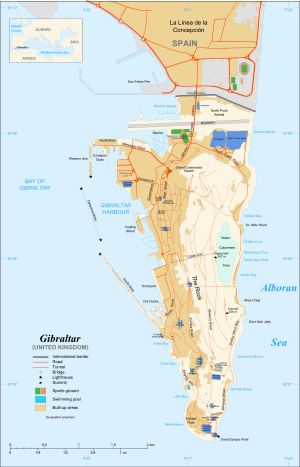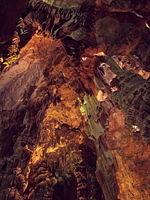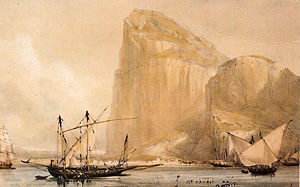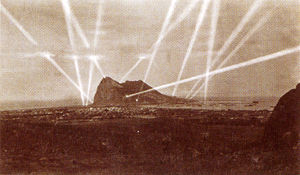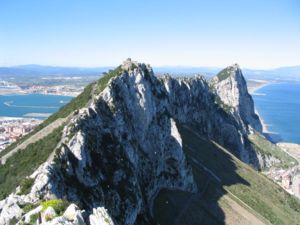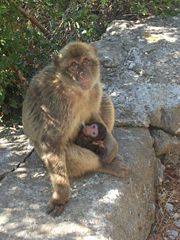Rock of Gibraltar
2008/9 Schools Wikipedia Selection. Related subjects: Geography of Great Britain
| Rock of Gibraltar | |
|---|---|
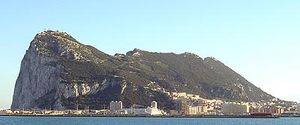 Western face of The Rock of Gibraltar, 2006. |
|
| Location of the Rock of Gibraltar's summit. | |
| Elevation | 426 metres (1,398 ft) |
| Location | Gibraltar |
| Range | Betic Cordillera |
| Prominence | 426 metres (1,398 ft) |
| Coordinates | |
| Age of rock | Jurassic |
| Easiest route | Cable car, Road, Hike |
The Rock of Gibraltar (sometimes called the Pillar of Hercules or by its Latin name, Calpe) is a monolithic limestone promontory located in Gibraltar, off the southwestern tip of Europe on the Iberian Peninsula. It is 426 metres (1,396 feet) high. The Rock is Crown property of the United Kingdom, and borders Spain. The sovereignty of Gibraltar was transferred to the Kingdom of Great Britain by the Treaty of Utrecht in 1713 after the War of the Spanish Succession. Most of the Rock's upper area is covered by a nature reserve, which is home to around 250 Barbary Macaques, commonly known as 'apes'; they are the only wild monkeys found in Europe. These macaques, as well as a labyrinthine network of tunnels, attract a large number of tourists each year.
The Rock of Gibraltar was one of the Pillars of Hercules and was known to the Greeks as Mons Calpe, the other pillar being Mons Abyla or Jebel Musa on the African side of the Strait. In ancient times the two points marked the limit to the known world, a myth originally fostered by the Phoenicians.
Geology
The Rock of Gibraltar is a monolithic limestone promontory ( ). The geological formation was created during the Jurassic period some 200 million years ago, when the African tectonic plate collided tightly with the Eurasian plate. The Mediterranean became a lake that, over the course of time, dried up during the Messinian salinity crisis. The Atlantic Ocean then broke through the Strait of Gibraltar, and the resultant flooding created the Mediterranean Sea. The Rock forms part of the Betic Cordillera, a mountain range that dominates south-eastern Iberia.
Today, the Rock of Gibraltar forms a peninsula jutting out into the Strait of Gibraltar from the southern coast of Spain. To the north, the Rock rises vertically from sea level up to 411.5 metres at Rock Gun Battery. The Rock's highest point stands 426 metres (1396 feet) above the strait. The near-cliffs along the eastern side of the Rock drop down to a series of wind-blown sand slopes that date to the glaciations, when sea levels were lower than today, and a sandy plain extended east from the base of the Rock. Its western face is comparatively less steep.
Calcite, the mineral which makes up limestone, dissolves slowly in rainwater. Over time, this process can form caves. Since the Rock of Gibraltar is made of limestone, it is not surprising that it contains over 100 caves. St. Michael's Cave, located halfway up the western slope of the Rock, is the most prominent and is a popular tourist attraction.
Gorham's Cave is located near sea level on the steep eastern face of the Rock. It is noteworthy because archaeological excavations in the cave have found evidence that Neanderthals used it as far back as 30,000 years ago. It is especially significant because plant and animal remains found in the cave (and others nearby) indicate that the Neanderthals had a highly varied diet.
Fortification
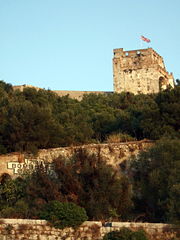
The Moorish Castle
The Moorish Castle is a relic of the Moorish occupation of Gibraltar, which lasted for 710 years. It was built in the year A.D. 711, when Tariq ibn-Ziyad, the Berber chieftain first landed on the Rock which still bears his name.
The principal building which remains is the Tower of Homage, a massive building of brick and very hard concrete called tapia, the upper part of which housed the living apartments and Moorish bath of the former occupants.
The Galleries
A unique feature of the Rock is its system of underground passages, known as the Galleries.
The first of these was dug towards the end of the four years’ siege which lasted from 1779-1783. General Elliot, afterwards Lord Heathfield, who commanded the garrison throughout the siege, was anxious to bring flanking fire on the Spanish batteries in the plain below the North face of the Rock. On the suggestion of Sergeant Ince of the Royal Engineers a tunnel was bored from a point above Willis’s Battery to communicate with the Notch, a natural projection from the North face on which it was proposed to mount a battery. There was no intention at first of making embrasures in this tunnel, but an opening was found necessary for ventilation, and as soon as it had been made a gun was mounted in it. By the end of the siege, six such embrasures had been constructed, in which four guns were mounted.
The Galleries, which are shown to visitors, were a later development of the same idea and were finished in 1797. They consist of a whole system of halls, embrasures, and passages, of a total length of nearly 1000 feet (304 metres), and from them may be seen a series of unique views of the Bay of Gibraltar, the isthmus, and Spain.
The Second World War onwards
When World War II broke out in 1939, the civilian population was evacuated to the United Kingdom, Jamaica, and Madeira so that Gibraltar could be fortified against the possibility of a German attack. By 1942 there were over 30,000 British soldiers, sailors, and airmen on the Rock. The tunnel system was expanded and the Rock became a keystone in the defense of shipping routes to the Mediterranean.
In February 1997, it was revealed the British had a secret plan called Operation Tracer to conceal service men in tunnels beneath the Rock in case it was captured by the Germans during World War II. The team in the rock would have radio equipment to monitor enemy movements. The team of six was sent to Gibraltar where they waited under cover for two and half years. The Germans never got close to capturing the rock, so the men were never sealed inside, and they were disbanded to resume civilian life when the war ended.
Invincibility
Despite long sieges it seemed that there was nothing that could destroy the Rock or its people. This history has inspired the simile "solid as the Rock of Gibraltar", which is used to describe a person or situation that cannot be overcome and does not fail. The motto of the Royal Gibraltar Regiment and even Gibraltar itself, Nulli Expugnabilis Hosti (Latin for "No Enemy Shall Expel Us"), reflects this invincibility. For this reason, an illustration of the Rock of Gibraltar is the corporate logo of Prudential Financial. The company's slogans have also referenced the formation.
The Upper Rock Nature Reserve
| Upper Rock Nature Reserve | |
|---|---|
| IUCN Category Ia ( Strict Nature Reserve) | |
|
|
|
| Location | Rock of Gibraltar |
| Nearest city | Gibraltar |
| Coordinates | |
| Established | 1993 |
| Governing body | Gibraltar Ornithological and Natural History Society |
Approximately 40% of Gibraltar's land area was declared a Nature Reserve in 1993.
Flora and fauna
The flora and fauna of the "Upper Rock Nature Reserve" are of conservation interest and are protected by law. Within it is a range of animals and plants, but the highlights are the Barbary Macaques (the famous Rock Apes), the Barbary Partridges, and flowers such as Gibraltar's own Chickweed, Thyme and the Gibraltar Candytuft.
Ornithology
The Rock of Gibraltar, at the head of the Strait, is a prominent headland, which accumulates migrating birds during the passage periods. The vegetation on the Rock, unique in southern Iberia, provides a temporary home for many species of migratory birds that stop to rest and feed before continuing migration for their crossing over the desert and sea. In spring they return to replenish before continuing their journeys to Western Europe, journeys which may take them as far as Greenland or Russia.
